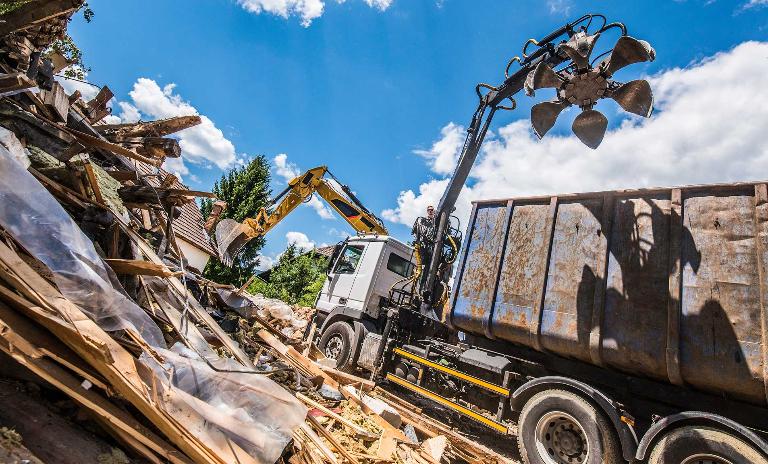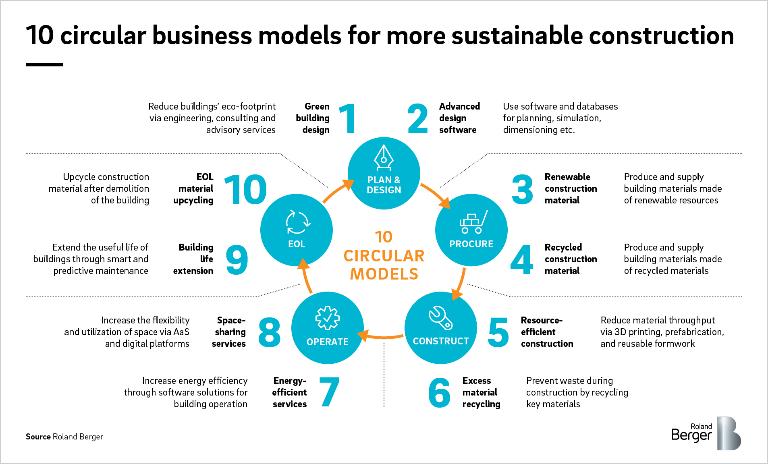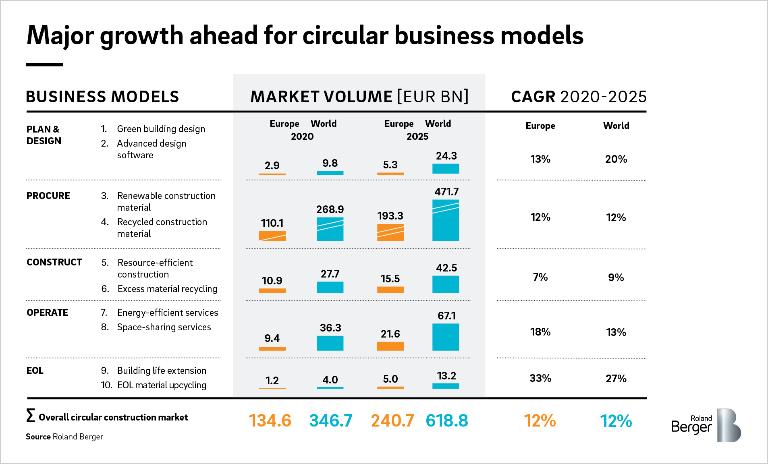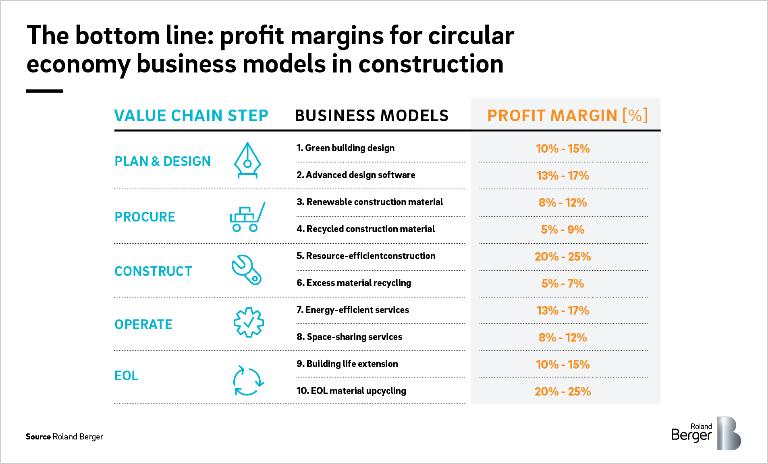Roland Berger is a thought leader in environmental issues and the response demanded from organizations. Our publications cover all relevant areas.


It’s time for construction to embrace the circular economy
How circular economy can drive greater sustainability and new business opportunities in construction
The construction industry is one of the world’s largest consumers of energy and raw materials. This is taking its toll on the environment: in the EU, construction is responsible for around 40% of CO2 emissions and nearly a third of all waste. But shifting from a linear to a circular economy would bring huge ecological improvements. What’s more, innovative new business models will account for an additional global market opportunity of more than EUR 600 billion by 2025, with a double-digit growth rate.

Good for planet, people and business
From water and electricity to steel and concrete, it takes a vast amount of resources to build our homes, offices and roads. But at what cost? In Europe, construction makes up more than a third of total energy consumption. And when buildings reach the end of their lifetime, only 40% of construction waste is recycled or reused. Most of these recycled materials are downcycled for second-grade construction like roads, rather than new buildings.
It’s no surprise, then, that construction features most frequently in European countries’ circular economy strategies. These aim to minimize (or even eliminate) waste and pollution by improving efficiency and keeping products and materials in use. For construction, this encompasses everything from the design phase through building, usage and eventually deconstruction and recycling.
However, the benefits of a circular approach go far beyond just the ecological. It can also bring significant social and economic gains. Using environmentally friendly construction materials has positive impacts on wellbeing, for example, and has been shown to increase productivity by up to 10%. By innovating business models along the entire value chain, we expect an additional global market of more than EUR 600 billion by 2025 with an annual growth rate of 12%. Europe will play a leading role in this circular economy with a market share of EUR 240 billion.
We have identified 10 innovative circular economy business models throughout the construction value chain that will drive sustainable development and growth in the industry. These start in the planning phase, where advanced software and eco-focused engineering and consulting services can optimize design. From there, a rapidly growing portfolio of renewable and recycled materials can be combined with efficient new construction methods such as 3D printing and prefabrication. Recycling of key materials at all stages can minimize waste. During operation, digital tools can drastically improve energy efficiency and utilization of space, as well as enabling smart predictive maintenance to extend a building’s life. At the end of life, upcycling keeps materials in use.
The pillars of a new ecosystem
Construction comprises a long and varied value chain. Forming a circular economy will require partnerships across the board, between both new and established players, to create an entirely new ecosystem. Progress is already being made and we have identified numerous examples of pioneering approaches that fit our new market model.
Established players are diversifying: One international engineering firm is applying green building design on a city scale to create more natural urban environments. A major architectural practice has created a new subsidiary for upcycled building materials to meet demand for more ‘circular’ products.
Forging new partnerships: A leading recycling business is forging valuable partnerships through a closed material recycling group. It currently numbers approximately 800 companies.
Enter the tech start-ups: A growing number of new tech players are disrupting the construction industry . One US-based company has created services to precisely track and steer energy use in buildings, bringing energy savings of up to 50%. IoT technology now enables one German company to monitor buildings and detect faults at an early stage to extend their lifespan.
New business models: The sharing and platform economies are also coming to construction. Flexible office-sharing can benefit both tenants and landlords, as well as reduce wasted space and resources. Meanwhile, a digital ledger for construction materials can prevent them from ‘disappearing’ as waste.
Building market volumes and profit margins
This new circular economy ecosystem will enable the construction industry, particularly in Europe, to discover new revenue and profit pools with strong growth of up to 30% per year. Within that, the scope for some new business models will be larger than others. Because of the market size, renewable and recycled materials will have the largest share. Currently, they make up more than 70% of the new circular construction market.
The rapid adoption of digital technology will fuel significant growth for new and innovative circular business models. We expect those in the planning and design phase to show 20% CAGR between 2020 and 2025. Models linked to operations will grow by 13% globally and 18% in the EU across the same timeframe. Hitherto largely undeveloped, the end-of-life phase will show the largest CAGR over the next four years: 33% in Europe and 27% worldwide.
As the circular economy grows, so too will the profit margins within each business model, albeit at varying rates. At one end of the scale, excess material recycling shows a profit margin of 5-7%, with recycled construction material at 5-9%. At the other end, technological innovation is driving profit margins of 20-25% in resource-efficient construction and end-of-life upcycling
Six factors for success
Embracing a more circular business model presents a variety of opportunities for companies throughout construction. To realize these, the industry must consider the following six success factors.
- Rethink the entire supply chain. Winning business models can only be conceived and implemented if all suppliers prioritize circularity over linear approaches.
- Consider the entire project lifespan. Analyze material and energy flows across the full lifetime of a construction project and optimize efficiency.
- Create a collaborative ecosystem. Holistic transformation can only be achieved by collaborating across the supply chain. Investors, designers and builders must create an ecosystem.
- Embrace digital technology. Innovation and R&D are the most potent enablers for circular business models in construction.
- Develop a business model planning process. A rigorous approach is vital to excel in this field. Built the necessary capabilities and create an investment strategy that includes ‘make or buy’.
- Expand and scale. Consider a market push to the most promising customers and scale newly acquired skills across an organization to leverage new business models.










